Microsoft has updated the rebooted Dev channel for Insiders with a new Build 23403. It comes with Keyboard shortcut hints in File Explorer, Live Captions available for more languages, a new Recommended section in File Explorer, improved Voice Access, and much more.
Advertisеment
What is new in Windows 11 Build 23403 for the Dev channel
Live Captions are available for more languages
The Live Captions feature helps all people read subtitles in their own language. Windows 11 2022 Update only supported English (US) subtitles. Starting with this build, the feature will also support Chinese (simplified and traditional), French, German, Italian, Japanese, Portuguese (Brazil), Spanish, and other dialects of English. The list of languages will be expanded in the future.
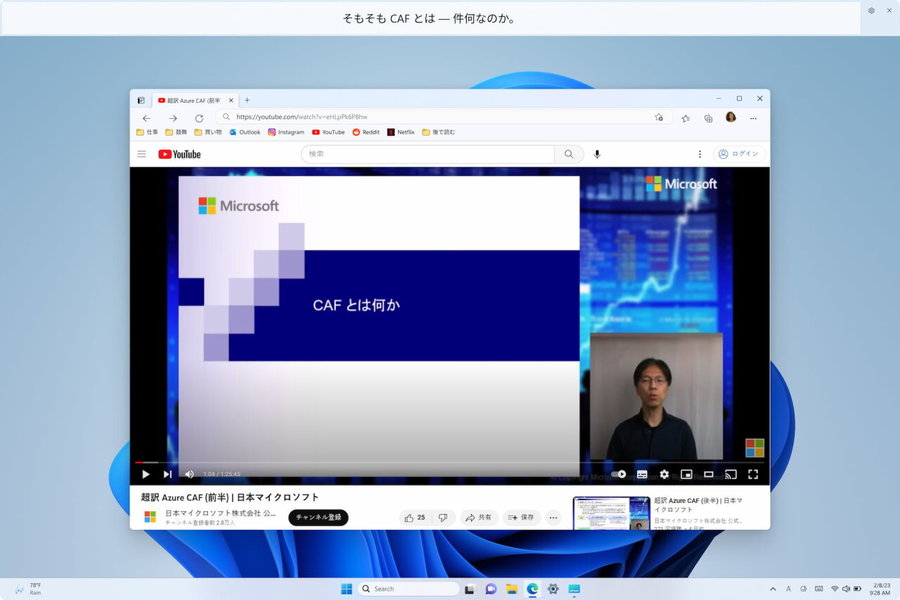
Live captioning can be enabled using the Win + Ctrl + L or from the Quick Actions flyout (Win + A). At the first start, the function will prompt you to download the necessary components for speech recognition on the device. If speech recognition support is not available in your Windows language of choice, or if you need another language, you can download the speech recognition components for Live captions in Settings > Time & Language > Language & Region .
Access Keys in File Explorer
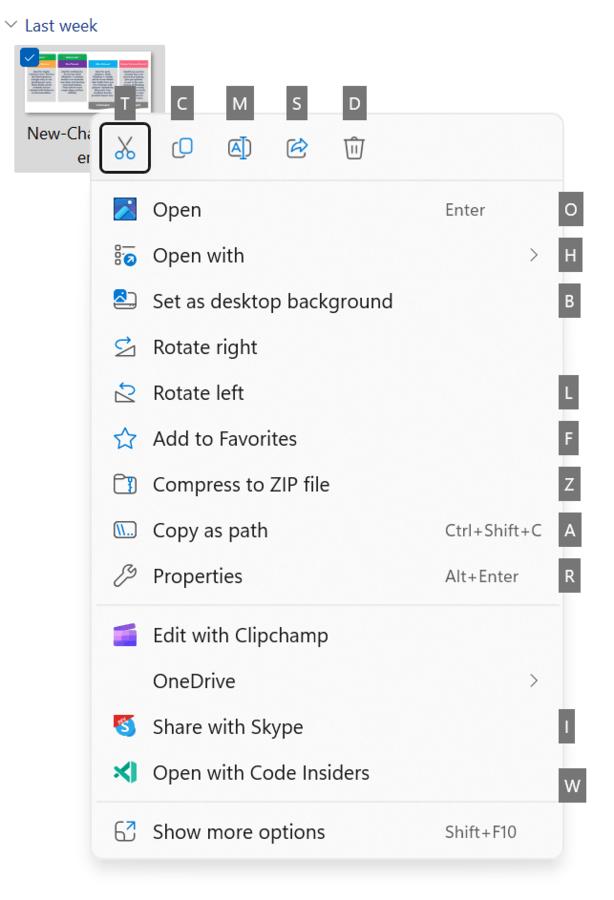
File Explorer can now show keyboard shortcut hints for the XAML-based context menu. The displayed letter or symbol indicates that you need to press to invoke the appropriate action. To try out the change, select any file and press the context menu key or Shift + F10 on your keyboard. Microsoft is rolling out this feature gradually.
Recommended Section in File Explorer
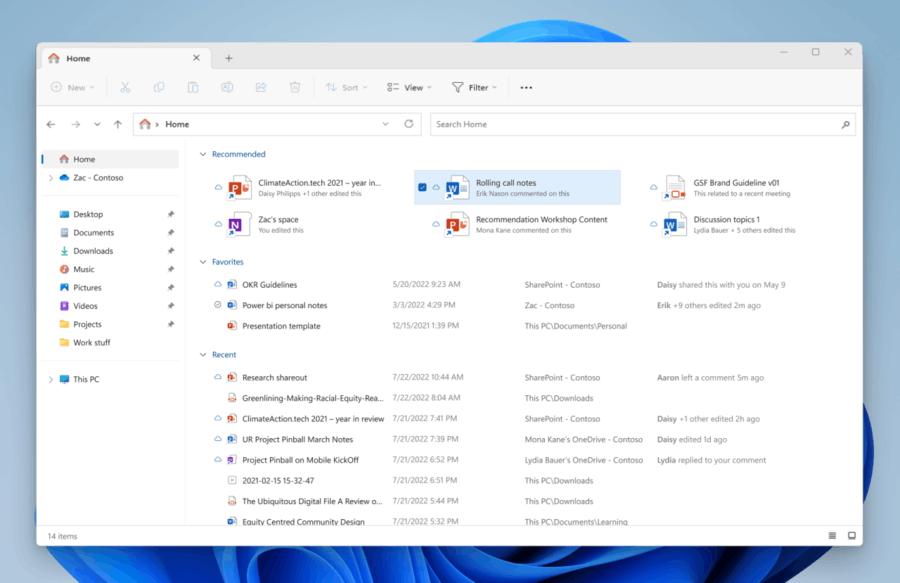
File Explorer's home page now displays recommended files to make it easier for you to find the most relevant content. This feature will only be available to users signed in to Windows with an Azure Active Directory (AAD) account. The recommended section will include online files associated with the account, as well as files owned by the user or shared with the user. Microsoft is rolling out this feature gradually.
Improved Voice Access
Redesigned in-app command help page: The search box allows users to quickly find the commands they need. Also, each category now has additional recommendations. Finally, you will find descriptions and examples of use for each of the commands.
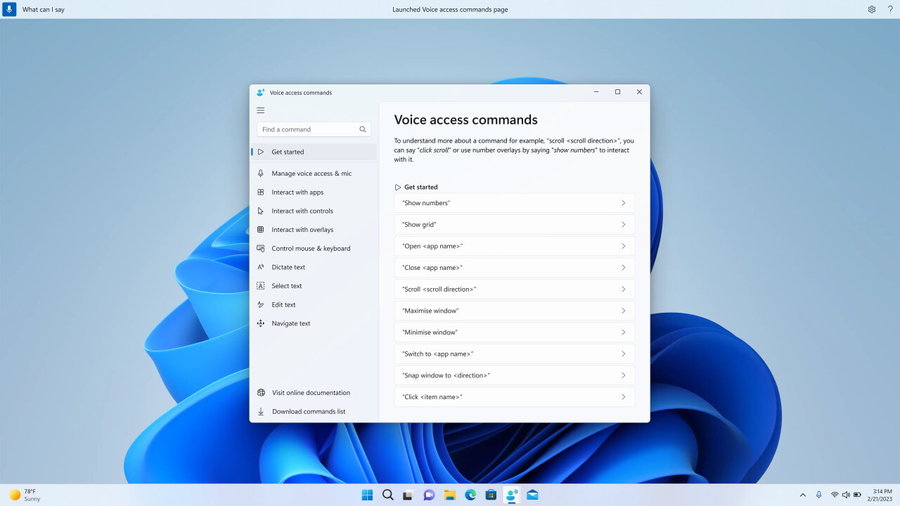
Note: The page may not contain all available commands, and additional information may not be accurate. This will be improved in future builds. If you want a comprehensive list of voice access commands and more information about them, check out the list on the Microsoft website.
Voice Access in English dialects. The feature now supports other dialects of English, including British, Indian, New Zealand, Canadian, and Australian. The first time you turn on Voice Access, you'll be prompted to download a speech model to enable voice recognition on your device. If Voice Access does not find a speech model that matches your language, you can still continue to use US English Voice Access.
NEW COMMANDS TO MAKE TEXT SELECTION AND EDITING EASIER
| To do this | Say this |
| Select a range of text in the text box | “Select from [text 1] to [text 2]”, e.g., “Select from have to voice access” |
| Delete all the text in a text box | “Delete all” |
| Apply bold/underline/italicize formatting on the selected text or last dictated text | “Bold that”, “Underline that”, “Italicize that” |
| Remove all whitespaces from selected text or last dictated textFor example, you dictated “Peyton Davis @outlook.com” in the last utterance and you want to remove all spaces to get the correct inbox address. | “no space that” |
| Insert “text” at the cursor and capitalize first letter of each word.For example, you want to insert “Hello World ” at the text cursor | “Caps [text]” ,e.g., “Caps hello world” |
| Inserts “text” at the cursor without any whitespace before “text”.For example, the text “Peyton” is entered in the text box and now you want to insert “Davis” but do not want a space to be added before Davis. (output: PeytonDavis) | “No space [text]” e.g., “No space Davis”” |
Updated Touch Keyboard Settings
There is now a drop-down menu that replaces the “Show the touch keyboard when there’s no keyboard attached” checkbox under Settings > Time & language > Typing > Touch keyboard. You can now pick one of the 3 options to specify when to launch the touch keyboard.
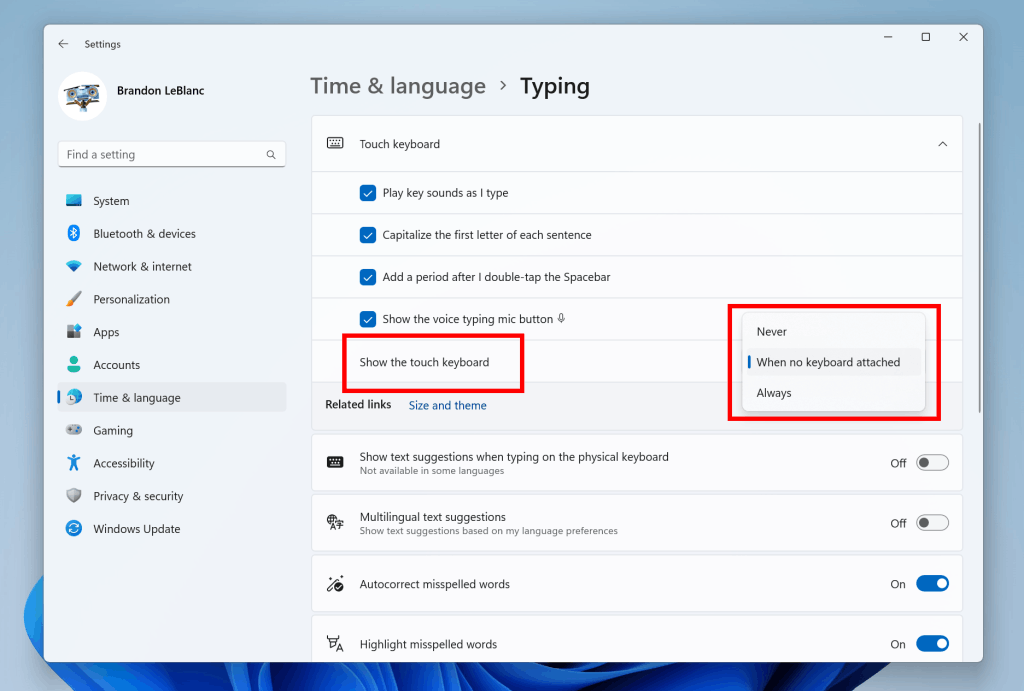
- “Never” suppresses the touch keyboard even when no hardware keyboard is attached.
- “When no keyboard attached” will show the touch keyboard only when the device is used as a tablet without the hardware keyboard.
- “Always” will show the touch keyboard even when the hardware keyboard is attached.
Microsoft is rolling out this feature gradually, so it will may take some time before you will see it on your device.
Narrator now supports Outlook
From now on, Narrator will receive updates to support Outlook. You can find detailed information about this on the official Microsoft website. These changes allow Microsoft to update the Outlook experience through the Microsoft Store. After the process is complete, you will receive a notification that the update is being installed. Narrator's Outlook support is currently limited to US English. Support for more languages is coming in future builds.
Multi-App Kiosk Mode
Multi-app kiosk mode is a feature that allows IT administrators to define which apps are allowed to run and block all others. Thus, it is possible to create several different applications and access configurations for different types of users on the same device.
Some of the available settings:
- Restrict access to "Settings", except for selected pages (for example, Wi-Fi and screen brightness).
- Restrict the Start menu to only show allowed apps.
- Block pop-up notifications and dialogs that cause unwanted user interface.
The multi-app kiosk mode is ideal for scenarios where multiple people need to use the same device. This may include HR and retail scenarios, training and testing.
Currently, multi-app kiosk mode can be enabled using PowerShell and WMI Bridge, with support for Intune/MDM and provisioning package configuration coming soon.
To configure using WMI, follow the instructions here. Using the Windows 10 sample XML will enable the feature, but will result in a blank start menu. To populate the Start Menu with your apps, follow these instructions to create a list of pinned apps, and then add it to the XML file after closing the StartLayout section, as shown below:
<win11:StartPins><![CDATA[ <em>Your JSON here </em>]]></win11:StartPins>
Don't forget to update the namespace by replacing the AssignedAccessConfiguration tag with the following:
<AssignedAccessConfiguration xmlns=”http://schemas.microsoft.com/AssignedAccess/2017/config” xmlns:win11=”http://schemas.microsoft.com/AssignedAccess/2022/config”>
Changes and Improvements
- General
- Users will now see a button to quickly copy two-factor authentication (2FA) codes in pop-up notifications from apps installed on a PC or smartphone connected to the PC via the Link to Phone app. If the system was unable to detect the code in the toast notification, then submit the appropriate feedback to the Feedback Hub. The feature is currently not available to all Insiders in the Dev channel.
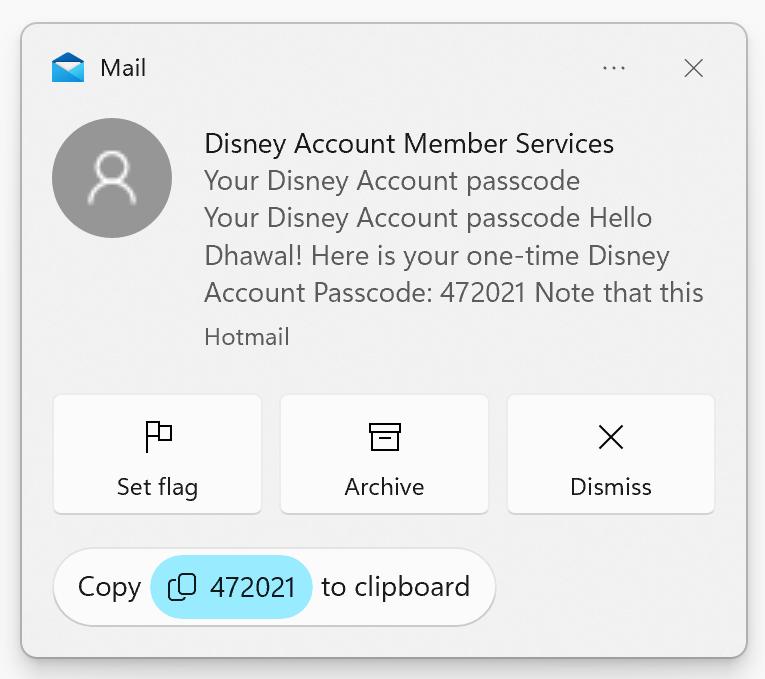
- Users will now see a button to quickly copy two-factor authentication (2FA) codes in pop-up notifications from apps installed on a PC or smartphone connected to the PC via the Link to Phone app. If the system was unable to detect the code in the toast notification, then submit the appropriate feedback to the Feedback Hub. The feature is currently not available to all Insiders in the Dev channel.
- Taskbar and system tray
- Added the ability to see the VPN status in the system tray when connecting to a recognized VPN profile. A small shield overlay icon will appear over the network connection tray icon. The shield currently does not use the system accent color, but this will change in the next build.

- Added the ability to see the VPN status in the system tray when connecting to a recognized VPN profile. A small shield overlay icon will appear over the network connection tray icon. The shield currently does not use the system accent color, but this will change in the next build.
- Taskbar search
- The search box on the taskbar will become lighter if Windows has a custom color scheme. For example, when dark theme is selected for Windows 11 and light theme for apps (under Settings > Personalization > Colors), the taskbar search box will be light.
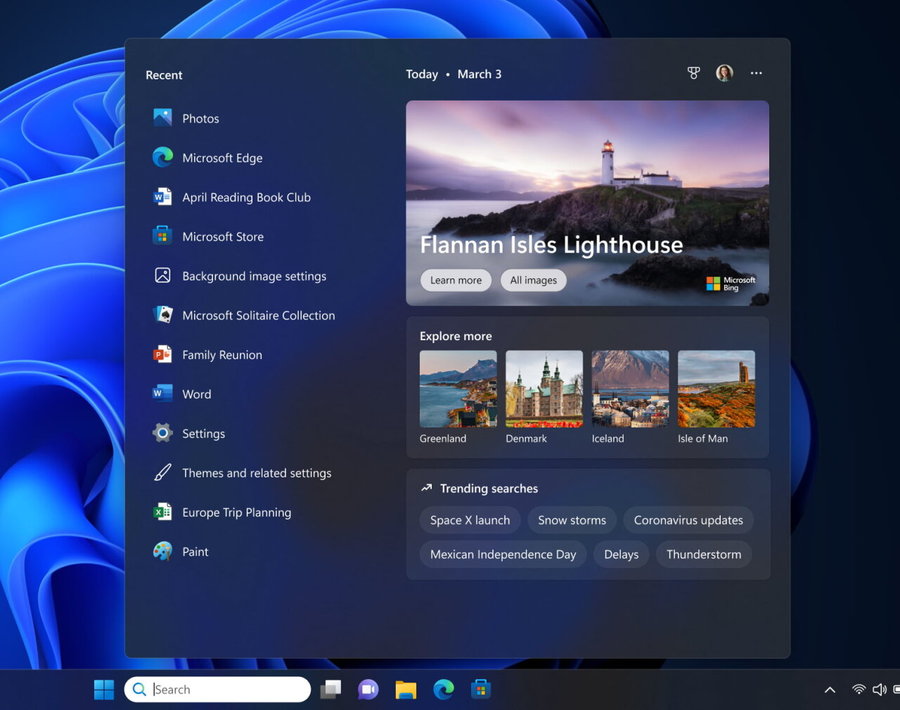
- The search box on the taskbar will become lighter if Windows has a custom color scheme. For example, when dark theme is selected for Windows 11 and light theme for apps (under Settings > Personalization > Colors), the taskbar search box will be light.
- Input
- Updated the Simplified Chinese handwriting recognition engine to be faster and more accurate. Also added support for characters defined in GB18030-2022. Currently, you can write GB18030-2022 level 2 characters and some GB18030-2022 level 1 characters in the handwriting panel or directly in the text box if supported.
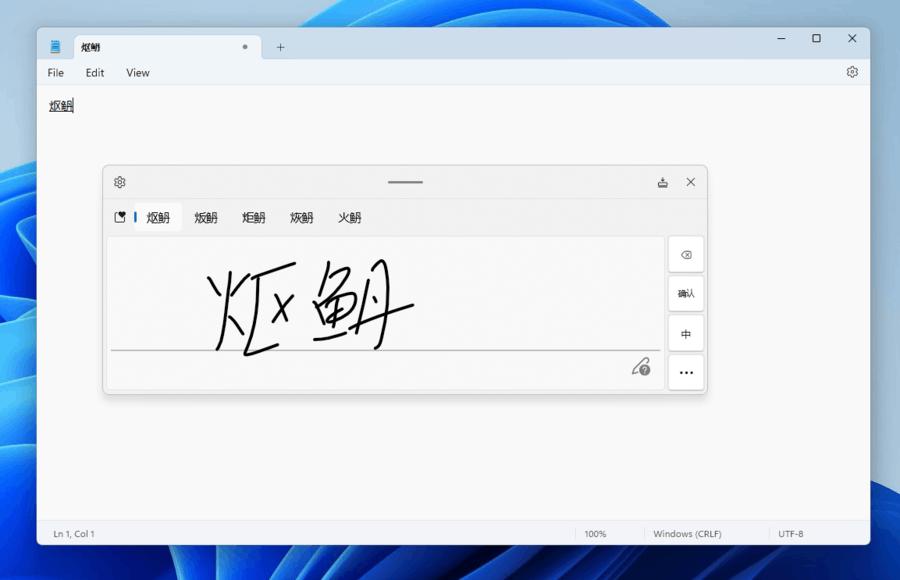
- Updated the Simplified Chinese handwriting recognition engine to be faster and more accurate. Also added support for characters defined in GB18030-2022. Currently, you can write GB18030-2022 level 2 characters and some GB18030-2022 level 1 characters in the handwriting panel or directly in the text box if supported.
- Settings
- If you right-click on a Win32 application in the Start menu or in Search and select Uninstall, this will open the Settings app. From there you can start the removal of the app.
Fixes
- Search on the taskbar:
- Fixed rendering issues that occurred when using the touch keyboard in the search box on the taskbar.
- Fixed an issue where double-clicking on a selection glyph would cause it to disappear.
- Fixed an issue that could cause the search box to disappear unexpectedly.
- Fixed an issue that caused the search icon to flip incorrectly in right-to-left languages.
- Fixed an issue where text in the search field could flicker when clicked.
- Fixed an issue where the search field could disappear from one of the monitors if you are using a multi-monitor configuration.
- Made some changes to accessibility settings for the search feature in Settings -> Personalization -> Taskbar.
- File Explorer
- Fixed an issue that is believed to be the cause of the File Explorer window sometimes unexpectedly appearing in the foreground.
Note. Some of the fixes listed above may be included in cumulative updates for release versions of Windows 11.
Known Issues
- File Explorer
- Keyboard shortcut hints may not appear if no keys are pressed. Pressing the key will make them appear.
- Problems with buttons for Recommended files:
- When you click on the "Share" button, a system window will open, not a window from OneDrive.
- When you click on the "File Location" button, an error window will appear, which can be closed.
- Clicking on the "Remove from list" button will not lead to any action.
- Live Captions
- On ARM64 devices, enhanced speech recognition support set on the Language and Region page will require restarting live captioning after changing the language in the subtitle menu.
- "Live Captions" for Traditional Chinese do not work on ARM64 devices.
- Some languages displayed on the Language & Region page support speech recognition (such as Korean), but do not yet support live captioning.
- When adding a language using the Language & Region page, the installation progress of language features may be hidden, and you will not see when the installation of Enhanced Speech Recognition (required for Live Captions) is completed. You can use "Language Options" to track progress. If this happens, there may be an unexpected delay before the Live Captions setup system detects the new language and allows you to continue.
- Subtitle display speed may be slower when using languages other than English. There is also no detection of languages other than English (United States), which means that incorrect subtitles may be displayed for speech other than the subtitle language.
- Voice Access
- Please note that the updated help page in the voice control application may not contain all commands, and additional information may not be accurate. It will be updated in future builds. If you want a comprehensive list of voice access commands and more information about them, check out the information on the Microsoft website.
Source: Microsoft
Support us
Winaero greatly relies on your support. You can help the site keep bringing you interesting and useful content and software by using these options:

Hello,
Unfortunately, there is no weather taskbar option.
Pascal.